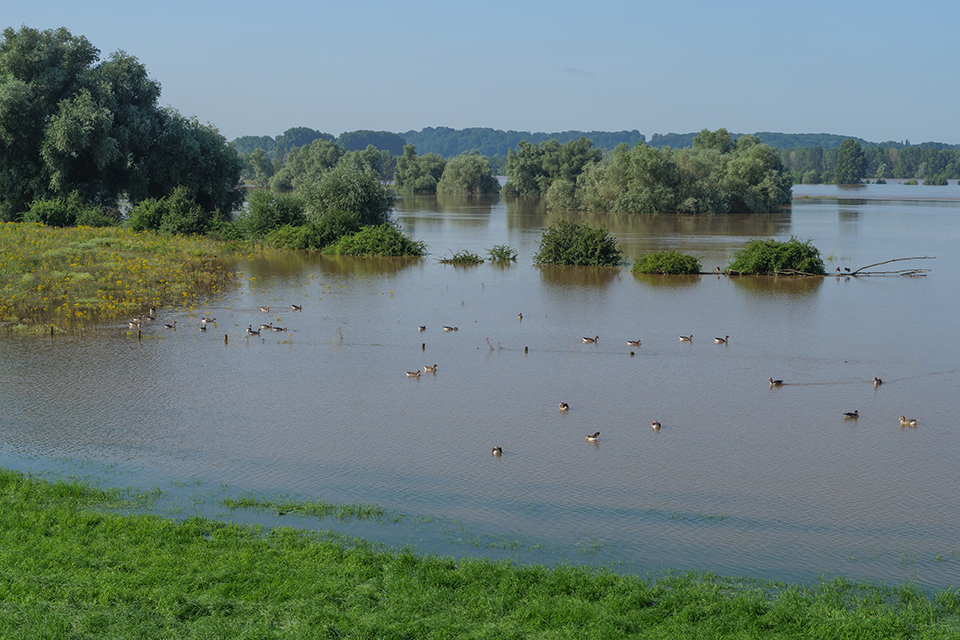Bislich, where the grave of Bodi was discovered more than fifty years ago, lies in the middle of a protected river landscape well worth visiting
In 1973-5 a huge burial ground from ca 500-800 was excavated at Bislich. One of the more spectacular graves belonged to a man called Bodi, who has become a symbol of the rich historical heritage characterising the landscape. However, the landscape also holds important nature.
Often flooded and waterlogged, the landscape near Xanten and Bislich offers vistas with willow bushes, floodplains, and wet grassland interspersed with tributaries and sidearms of the river Rhine. In the landscape lies a protected nature reserve, the Bislicher Insel covering 1000 ha, which is classified as Natura 2000.
Initially, the island was a peninsula. However, after 1788, a new channel was dug, leading the river Rhein closer to Bislich. Today the former peninsula and, with it, the former main river bed has become a waterlogged and often flooded landscape of islets in the Rhine to the south of Xanten. The area was already protected in 1940, and in the last 30–40 years, the government has bought up land to secure the nature reserve, which is considered nationally important. Until c. 1990, the core area was grazed but is now managed according to the principles of passive rewilding (that is, without the contribution of large mammals). Grazing is kept in the periphery.
On the island, the RVR Naturforum can be found. This information centre is reached from the small hamlet Bislich on the left side of the river by finding the pedestrian ferry. Or it may be reached by car from Xanten. Surrounding the nature reserve are large pastures owned by the government and leased to farmers on condition of the use of limited fertilising and (somewhat extensive) grazing. The landscape is said to have improved since the curtailing of the more intensive grazing allowing for the return of reed belts and the opening of dikes. However, the lack of grazing in the core area is currently thought to further a process whereby the first hawthorn-dogwood bushes and dewberry are now rapidly being superseded by ash and oak trees growing nearby. The area is handled by the Naturschutz Zentrum im Kreiss Kleve.
Unfortunately, though, recently published studies of the general condition at Bieslicher Insel show that both phosphate and herbicides show relatively high levels due to the intensive agricultural practices further inland. These influences undoubtedly cause a significant degrading effect on the strictly protected habitats at the Bieslicher Insel, causing eutrophication. This study calls for the establishment of buffer zones, a well-documented tool to protect vulnerable habitats such as at Bislich. As the Bislicher Insel is registered as Natura 2000, one should imagine it was protected through such buffer zones. Unfortunately, that is not the case. ”A solution to reduce the input of fertilisers and herbicides in nature reserves would be to switch to organic farming with special rules and conditions in the direct neighbourhood of these areas”, write the authors (Köthe 2023). They propose a 75 m protective zone around such nature reserves as Bieslicher Insel.
Nature at Bislich
Nevertheless, the landscape is considered a Mecca for birdwatchers looking out for spotted redshanks, Common greenshanks, Great egrets, Common Terns, and other rare bleeding and migrating birds, like the very rare Lesser White-Fronted Geese. Less than fifteen pairs and perhaps 60-80 individuals breed in Northern Sweden. Their migratory path runs across the Bislicher Insel. It belongs to one of the most endangered bird species in the world, primarily threatened by loss of habitat and illegal poaching. The presence of the geese is due to a controversial project set up in 1999 when a Frenchmen flew in a very small aeroplane through a hunting-prohibited corridor followed by 30 geese, which he had raised and hence acclimatised to people. Landing near Bislich, the geese overwintered to return to their breeding grounds in Finland next summer. The staus of this project, though, is somewhat murky. Recently, the nature reserve has also featured White-Tailed Eagles breeding with success. But spoonbills, black kites, and white storks can also be spotted in unusually high densities.
The nature reserve is protected, meaning swimming, fishing or riding is prohibited. However, a network of paths is laid out. A core of the nature reserve is curtailed during summer to protect the breeding eagles.
Management Principles
SOURCES:
Bislicher Insel Nature Reserve (WES-005)
Negative spill-over effects of agricultural practices on plant species conservation in nature reserves
By S Köthe, N. Bakanov, C.A. Brühl, B. Gemeinholzer, T. Hörren, R. Mühlethaler, M. Sorg, H. Sumser, S.J. Swenson, G.U.C. Lehmann.
In: Ecological Indicators (2023) vol 149
